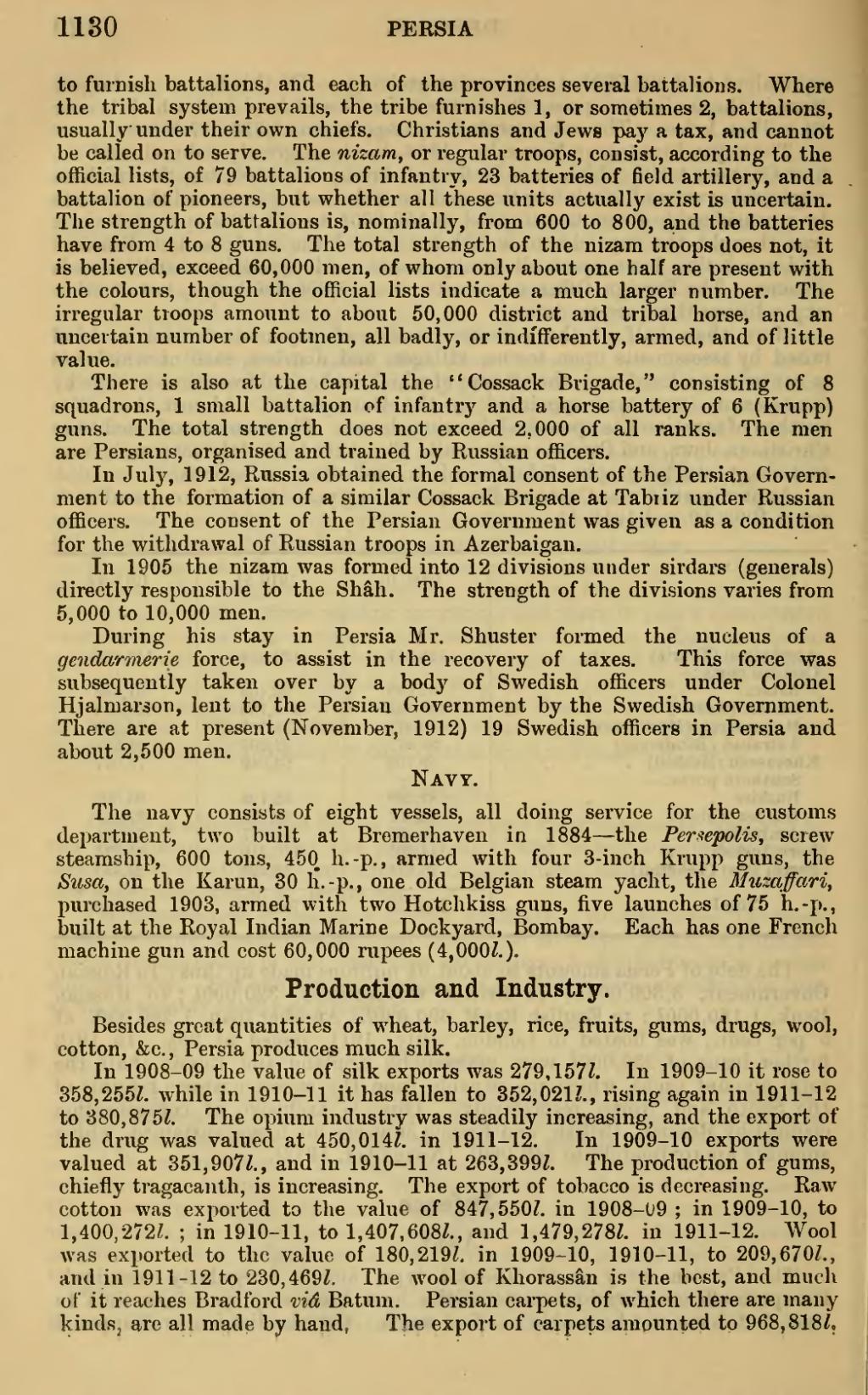1180 PERSIA
to furnish battalions, and each of the provinces several battalions. Where the tribal system prevails, the tribe furnishes 1, or sometimes 2, battalions, usually under their own chiefs. Christians and Jews pay a tax, and cannot be called on to serve. The nizam, or regular troops, consist, according to the official lists, of 79 battalions of infantry, 23 batteries of field artillery, and a battalion of pioneers, but whether all these units actually exist is uncertain. The strength of battalions is, nominally, from 600 to 800, and the batteries have from 4 to 8 guns. The total strength of the nizara troops does not, it is believed, exceed 60,000 men, of whom only about one half are present with the colours, though the official lists indicate a much larger number. The irregular troops amount to about 50,000 district and tribal horse, and an uncertain number of footmen, all badly, or indifferently, armed, and of little value.
There is also at the capital the "Cossack Brigade," consisting of 8 squadrons, 1 small battalion of infantry and a horse battery of 6 (Krupp) guns. The total strength does not exceed 2,000 of all ranks. The men are Persians, organised and trained by Russian officers.
In July, 1912, Russia obtained the formal consent of the Persian Govern- ment to the formation of a similar Cossack Brigade at Tabiiz under Russian officers. The consent of the Persian Government was given as a condition for the withdrawal of Russian troops in Azerbaigan.
In 1905 the nizam was formed into 12 divisions under sirdars (generals) directly responsible to the Shah. The strength of the divisions varies from 5,000 to 10,000 men.
During his stay in Persia Mr. Shuster formed the nucleus of a gendarmerie force, to assist in the recovery of taxes. This force was subsequently taken over by a body of Swedish officers under Colonel Hjalmarson, lent to the Persian Government by the Swedish Government. There are at present (November, 1912) 19 Swedish officers in Persia and about 2,500 men.
Navy.
The navy consists of eight vessels, all doing service for the customs department, two built at Bremerhaven in 1884 — the Per<tepolis, screw steamship, 600 tons, 450 h.-p. , armed with four 3-inch Krupp guns, the Susa, on the Karun, 30 h.-p., one old Belgian steam yacht, the Muzaffari, purchased 1903, armed with two Hotchkiss guns, five launches of 75 h.-p., built at the Royal Indian Marine Dockyard, Bombay. Each has one French machine gun and cost 60,000 rupees (4,000Z.).
Production and Industry.
Besides great quantities of wheat, barley, rice, fruits, gums, drugs, wool, cotton, &c. , Persia produces much silk.
In 1908-09 the value of silk exports was 279,157Z. In 1909-10 it rose to 358,255Z. while in 1910-11 it has fallen to 352,021?., rising again in 1911-12 to 380,875?. The opium industry was steadily increasing, and the export of the drug was valued at 450,014Z. in 1911-12. In 1909-10 exports were valued at 351,907?., and in 1910-11 at 263,399?. The production of gums, chiefly tragacanth, is increasing. The export of tobacco is decreasing. Raw cotton was exported to the value of 847,550?. in 1908-09 ; in 1909-10, to 1,400,272?. ; in 1910-11, to 1,407,608?., and 1,479,278?. in 1911-12. Wool was exported to the value of 180,219?. in 1909-10, 1910-11, to 209,670?., and in 1911-12 to 230,469?. The wool of Khorassan is the best, and much of it reaches Bradford vid Batum. Persian carpets, of which there are many kindsj are all made by hand, The export of carpets amounted to 968,818/,
